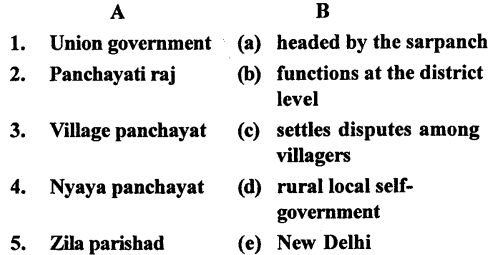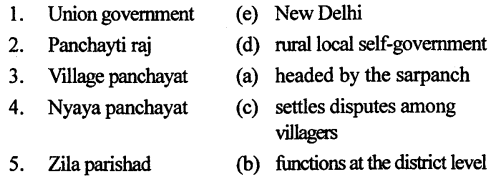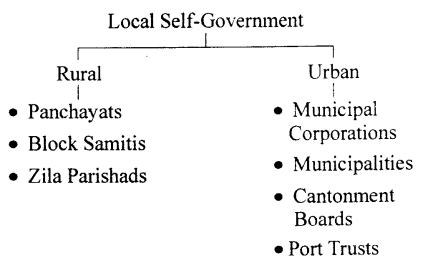The Trail History and Civics for Class 6 ICSE Solutions – Rural Local Self-Government
ICSE SolutionsSelina ICSE SolutionsML Aggarwal Solutions
The Trail History and Civics for Class 6 ICSE Answers
Trail HistoryCivicsHistory & Civics Geography Biology Chemistry Physics Maths
Keywords
- Panchayati raj system: It is the system under which the local self-government at the village level functions.
- Gram sabha: It consist of all the adult members of the village.
- Gram panchayat: It consist of a number of senior members of the village elected by the gram sabha.
- Nyaya panchayat: It consist of elected members who settle disputes among village people.
- Pradhan: He is the heat of the gram panchayat. Up-Pradhan He is the vice-sarpanch of the panchayat who takes over the responsibilities of the sarpanch in his/her absence.
EXERCISES
A. Fill in the blanks:
- The Indian government function at the central, state government and local self government levels.
- The union government deals with matters of national importance.
- All Adult members of the village are members of the gram sabha.
- The nyaya panchayat cannot sent people to Jail.
- The gram panchayat makes the villagers more responsible and self-sufficient.
B. Match the following:

Answer:

C. Choose the correct answer:
1. The union government of India is based in New Delhi/ Mumbai/Kolkata.
Ans. The union government of India is based in New Delhi.
2. Rural refers to town/villages/cities.
Ans. Rural refers to villages.
3. The panchayati raj is a two/three/Jive-ther
Ans. The panchayati raj is a three-tier system.
4. One third/One sixth/One fourth of the seats of the gram panchayat are reserved for women.
Ans. One third of the seats of the gram panchayat are reserved for women.
5. The panchayat/block samiti/zila parishads is the local self-government body at the block level.
Ans. The block samiti is the local self-government body at the block level.
D. State whether the following are true or false:
- The Local self-government deals with matters of national importance.
False.
Correct : The Local self-government deals with matters of locality. - Panchayats are elected for 2 years.
False.
Correct: Panchayats are elected for 3 to 5 years. - The village panchayat is the basic unit of the panchayati raj system.
True. - The Panchayat provides primary education.
True. - The Nyaya Panchayat tries petty civil and criminal cases.
True.
E. Answer the following questions in one or two words/ sentences:
Question 1.
What are the three tiers of the panchayati raj system?
Answer:
The three-tiers of panchayati raj system is as:
- Panchayats at the village legel,
- Block samitis at the block level,
- Zila parishads at the district level.
Question 2.
Who is the head of the village panchayat?
Answer:
The village panchayat is headed by the pradhan or sarpanch.
Question 3.
Mention any one optional function of the gram panchayat.
Answer:
- It builds playgrounds and rest houses, installs television and radio sets in the community centers, and organizes educational programmers, etc.
- It organizes cattle fairs and village markets.
Question 4.
What does the nyaya panchayat do?
Answer:
Its function is to settle disputes among the people. It also provides a cheap and speedy way to resolve disputes.
F. Answer the following questions briefly:
Question 1.
What are the functions of the union, state and local self-governments?
Answer:
- Union (Central government) deals with matters of national importance like defence, national finance, foreign, exchange, railways, postal services etc.
- State government maintain law and order, local transport, health services and it also carries out the community development programmer.
- Local self-government deals with local problems and looks after the basic needs of the local people.
Question 2.
What is local self-government? Name the two kinds of local self-governing bodies in India?
Answer:
It is a government run by the elected representatives of the local people. In India there are two kinds of local self-government.
They are following.
- Urban: It refers to towns and cities. Municipalities, corporations and cantonment boards are urban local bodies.
- Rural: It refers to villages. Zila parishads, block samitis and panchayats are rural local bodies.
Question 3.
Mention any five compulsory functions of the Gram Panchayat.
Answer:
They are following:
- It provides drinking water, school, health and sanitation facilities.
- It constructs buildings, roads, drains and tanks.
- It helps farmers to develop and improve their farms and cattle.
- It looks after the welfare of the weaker sections.
- It organizer educational programmes, cattle fair and village markets.
Question 4.
What is the importance of Gram Panchayats?
Answer:
The Gram Panchayat assists the villagers in dealing with day- to-day problems. It performs administrative, social, economic and judicial function. It ensures the participation of the villages in developing their community. Hence, people learn to cooperate and participate in the government of the country at the grass-roots level.
G Picture study.
This is village scene representing an important function of the gram panchavat.

1. Name the function.
Ans. A gram panchayat in session —gram panchayats ensure that villages participate in their own development.
2. Is it a compulsory or an optional function?
Ans. It is compulsory function.
3. Mention four compulsory functions of the village panchayat.
Answer:
The functions of the village Panchayat are following:
- It provides drinking water, Primary schools, health and sanitation facilities.
- It constructs buildings, road and drains.
- It records births and deaths in the village.
- It helps farmers to develop and improve their farms and cattle.
4. Mention two optional functions of the panchayat.
Answer:
- It builds playgrounds and rest houses.
- It organizes cattle fairs and village markets.
OTHER IMPORTANT QUESTIONS
Question 1.
Make a Block diagram of Local self-government?
Answer:

Question 2.
Name three parts of panchayati system at the villages.
Answer:
- Gram Sabha
- Gram Panchayat
- Nyaya Panchayat
Question 3.
Why is panchayati raj a three-tiered system?
Answer:
Because this was done to involve the people of the villages in the management of their own affairs.
Question 4.
Why do you think panchayats are so important in this country?
Answer:
India is vast country with a large population. The Prime Minister alone cannot attend to each and every need of the people in remote village. To make the task of administration easier the government in India operates panchayat.
Question 5.
List three functions of:
(1) Block samiti and
(2) Zila parishads.
Answer:
Functions of Block Samiti:
- It supervises the working of the village panchayats.
- It arranges funds from the government for block development programmers.
- It prepares the community development programmer for their area.
Functions of Zila Parisad:
- It supervises the working of the block samitis and panchayats.
- It advises the state government on the working of the panchayati raj system.
- It approves the budget of the block samitis and distributes funds among them.
Question 6.
What are some of the sources of income for block samitis and zila parishads?
Answer:
The sources of income for block samitis and zila parishad are following:
- The state government and the central government give grants and aids.
- It advised the state government on the working of the panchayati raj system.
- Taxes are imposed on land, houses, water, electricity, fairs and cattle.